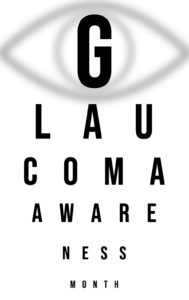January is Glaucoma Awareness Month.
The National Eye Institute states glaucoma is the leading cause of preventable blindness, and most individuals are unaware they have the disease.
There is no cure for glaucoma so early detection and treatment is critical to limit any extent of damage.
Warning signs of glaucoma include loss of peripheral vision, vision loss, redness in the eye, eyes that appear hazy or cloudy, and pain in the eye or head. If these symptoms are being caused by glaucoma, the disease is past an early stage and damage is being inflicted.
 Getting a comprehensive dilated eye exam is the best way to protect your vision from this degenerative eye disease and others.
Getting a comprehensive dilated eye exam is the best way to protect your vision from this degenerative eye disease and others.
While anyone can get glaucoma, some are more at risk than others. According to the National Eye Institute, high-risk groups for the disease include people of African, Hispanic or Asian descent. Other high-risk groups include anyone over the age of 60, individuals who are extremely near-sighted, or if they have a history of diabetes in their family.
Even if an individual does not belong to a high-risk group, it is recommended that individuals receive a comprehensive dilated eye exam by the age of 40 to catch glaucoma or other eye diseases early on.
While glaucoma is a disqualifying condition prior to enlistment, servicemembers who get the disease while they’re in the service generally continue their service for years after the diagnosis — on average, about 4.5 years. Swift medical treatment allows affected Airmen to continue their line of work with little interruption.
For more information, or to schedule an appointment for a comprehensive dilated eye exam, call the Ramstein Air Base medical clinic at DSN 479-2273 or commercial 06361 462273.







